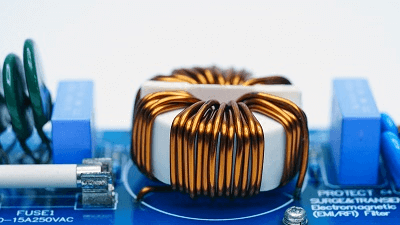What Is an Inductor (Coil)?
 An inductor (coil) is an electronic component. It is a coil of conductive wire wound around a magnetic core such as iron.
An inductor (coil) is an electronic component. It is a coil of conductive wire wound around a magnetic core such as iron.
It is a basic electronic component like resistors, diodes, and capacitors, and is used in a high percentage of electronic devices. An inductor (coil) has several distinctive functions.
When a current tries to flow through an inductor (coil), it interferes with this flow, and conversely, when the current tries to decrease, it tries to increase it. In addition, when a signal with a high frequency tries to pass through the inductor, the inductor tries to block it.
Taking advantage of the above characteristics, inductors are used in a wide range of applications, such as automobiles, communication equipment, and precision instruments, to eliminate noise and select necessary signals in the circuits of electronic equipment.
Uses of Inductors (Coils)
Inductors (coils) are widely used in electrical and electronic circuits and are one of the essential components of industry. The following are examples of applications of inductors (Coil).
1. Switching Power Supplies
The power outlet in our homes provides 100 VAC voltage, but many electronic circuits operate on DC current. A device that converts AC to DC is called a switching power supply. A switching power supply contains an inductor (coil).
The inductor (coil) is used to smooth the current and eliminate unwanted high-frequency noise by taking advantage of its property to prevent sudden changes in the current.
2. Use as a Transformer
Generally, two inductors (coils) are used in a transformer. When voltage is applied to the coil on the input side, a magnetic field is generated in the coil, which is induced in the inductor (coil) on the output side. The inductor (coil) on the output side receives the magnetic field and generates a voltage.
In this way, the high-voltage electrical energy on the input side is converted into low-voltage electrical energy on the output side. The voltage can be adjusted by changing the number of conductor turns of the inductor (coil).
3. Communication Equipment
Inductors (coils) are also used in communication circuits. Radio receiving circuits, for example, have built-in inductors, and received signals can be amplified by passing received radio waves through the inductors.
In addition, an inductor (coil) dedicated to high-frequency circuits, called a toroidal core, may be used in communication equipment. This inductor (coil) prevents leakage of magnetic flux and can produce efficient inductance in the desired frequency band.
Principle of Inductors (Coils)
An inductor (coil) consists of copper wire wound in a spiral shape. A ferromagnetic material such as iron or ferrite may be inserted in the center of the winding, which allows for miniaturization at the cost of increased weight.
According to Fleming’s left-hand rule, when an electric current flows through an inductor (coil), a magnetic field is generated and converted into magnetic energy. The more turns and the smaller the diameter of the coil equates to a stronger magnetic flux and therefore the higher the magnetic energy.
When an alternating current flows through the inductor (coil), the magnetic field changes in accordance with the frequency. This magnetic field change generates an electromotive force, which is the self-induced electromotive force. The magnitude of the self-induced electromotive force varies depending on the size of the inductor and the number of conductor turns, and is called inductance, using the unit henry (H). The inductor (coil) acts to prevent the rate of change of the current over time.
Inserting an inductor (coil) in an AC circuit causes a phase delay. Also, when an inductor (coil) is inserted into a DC circuit, it interrupts the current during the transient period and maintains the current after the power supply is cut off.
Types of Inductors (Coil)
There are several types of inductors (coil). The following are examples of inductor (coil) types.
1. Air-Core Coil
An air-core coil is an inductor (coil) in which the center of the coil is hollow. Since the shape of the coil wire wound around the coil is free, self-induction can be enhanced. However, air coils tend to be large and are not often used except for high-frequency applications.
2. Iron-Core Coil
An iron-core coil is an inductor (coil) with an iron core in the center of the coil. The iron core enhances self-induction and can handle large amounts of power. Since the size can also be reduced, they are used in a wide range of applications.
3. Ferrite Core Inductor
Ferrite core inductors (coils) are inductors that use a magnetic core material called ferrite. Ferrite has high magnetic permeability at high frequencies, making it suitable for high-frequency circuits. They may also be designed as inductors for a specific frequency range, depending on the core material.